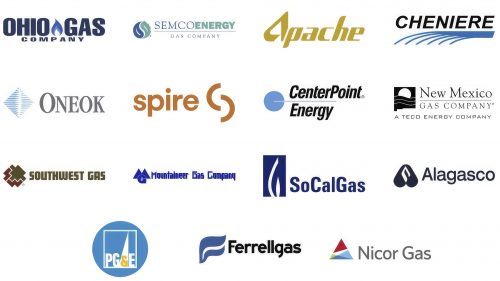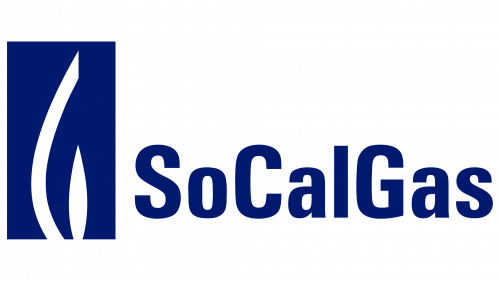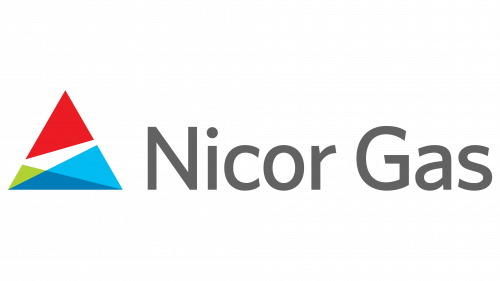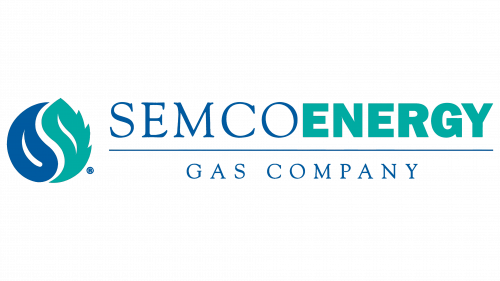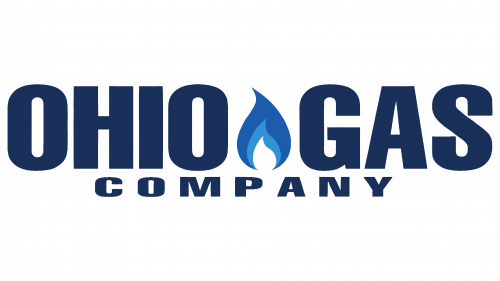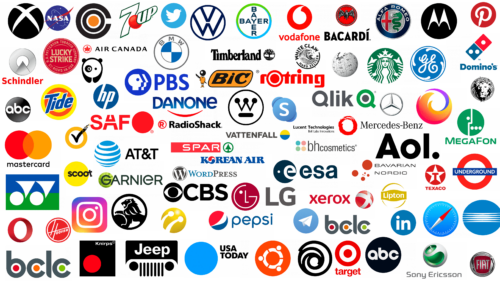The gas industry is super important for giving us energy. It helps keep our houses warm, cars running, and factories working. Companies that work with gas are big players in the energy world. They’re important because they make a lot of money, and their logos and brands show they care about making energy better and more earth-friendly.
Gas companies find and extract natural gas from the ground, a cleaner fuel than coal or oil. They then distribute this gas to people worldwide. Nowadays, these companies are also trying to be more green. They’re looking into ways to use energy that’s good for our planet, like reducing pollution.
Having a cool logo and brand helps a company stand out in the world of many gas companies. A good logo tells you what the company stands for, like being innovative or caring about the planet. It helps people trust the company more.
When creating a logo, gas companies think about a few things:
- What the logo shows: They use pictures or symbols that make you think of energy, like flames or the earth, and show they’re thinking about the future and the environment.
- Colors: They pick colors that give off the right vibes. Blues and greens can make you think of a clean, healthy earth, while reds and yellows feel warm and energetic.
- Keeping it simple: A great logo is easy to recognize and remember but also means something special.
To wrap up, gas companies are important in ensuring we have the energy we need. Their logos do more than just look nice; they tell us about the company’s mission to provide energy in better ways for the planet. These logos remind us that the gas industry is always changing, trying to be better and more responsible.
Cheniere Energy
Cheniere Energy, started by Charif Souki on February 21, 1996, in Houston, Texas, switched its focus from looking for oil and gas to working with liquefied natural gas (LNG). They decided to build an LNG terminal in Sabine Pass, Louisiana, starting in March 2005. By 2016, this terminal became the first one in the lower 48 states of the U.S. to send LNG to other countries, showing Cheniere’s big role in the world’s LNG market.
At first, Cheniere got money from investors like Warburg Pincus and, in 2003, got the green light to build an LNG terminal for bringing gas into the U.S. But Cheniere sent LNG abroad instead when the U.S. started producing lots of shale gas. In 2010, they got permission to build this export terminal. Between 2018 and 2021, they expanded a lot, with the Sabine Pass and Corpus Christi terminals making it possible to send more LNG overseas. Now, Cheniere Energy is a key player in sending American LNG all over the world.
Like a doorway to worldwide energy solutions, the Cheniere logo embodies the company’s spirit of innovation and goal of leading the LNG industry.
Oneok
ONEOK, originally called Oklahoma Natural Gas Company, started in 1906 in Tulsa, Oklahoma. C.B. Ames and Ryan Haynes founded it to manage gas pipelines around Tulsa. From these humble beginnings, it became a big name in the natural gas field.
During the Great Depression in 1935, the company changed significantly and got a new name, ONEOK, to show it had bigger plans than just serving Oklahoma. Over the years, it built more pipelines to help more places in Oklahoma and nearby areas, especially in the 1940s. In the 1980s, when rules about energy companies got looser, ONEOK expanded into energy trading and marketing.
In 1998, ONEOK split into two parts, ONEOK Inc. and ONEOK Partners, to do better in the energy services area. At the start of the 2000s, ONEOK bought other companies to get better at handling natural gas liquids.
By merging with ONEOK Partners in 2018, ONEOK streamlined its business and maintained its place as a big company in the energy market. Now, it’s known for its work moving and processing oil and natural gas in some of the top shale-producing areas in the U.S.
The ONEOK logo shows its rich history and push toward new energy solutions, showing how it went from a small pipeline company to a major player in the U.S. energy scene.
Apache
Apache Corporation was started on December 6, 1954, by Truman Anderson, Raymond Plank, and Charles Arnao in Minneapolis, Minnesota. They picked the name “Apache” because it stood for the toughness and dreams they had for their company. At first, Apache was about finding and getting natural gas, crude oil, and natural gas liquids. The company grew and now works not just in the United States but also in Canada, Egypt, and the United Kingdom, with its main office in Houston, Texas.
Apache had a big moment in 1956 when they finished their first oil well in Tulsa, Oklahoma. This made them well-known in the oil and gas field. Then, they moved to Denver, Colorado, in 1967 to be closer to where they were exploring for oil and gas. By 1969, being listed on the New York Stock Exchange helped them grow even more. During the 1980s and 1990s, Apache focused on specific areas in the U.S., like the Anadarko and Permian basins, and expanded into the Gulf of Mexico, Canada, and Egypt.
In 2016, Apache bought assets in the Permian Basin in Texas for $3.75 billion, making a big name in that area. Apache is now a top oil and gas exploration company with over 3,000 employees worldwide. It concentrates on big shale areas in Texas, Oklahoma, and the Gulf of Mexico.
Apache’s logo represents its strength, resilience, and ambition. It represents the company’s long history and goals for the future in the energy industry.
PG&E (Pacific Gas and Electric Company)
Pacific Gas and Electric Corporation, or PG&E, is a big company in San Francisco, California, that produces a lot of clean energy. It has 75 power plants and produces 6,871 megawatts of electricity, most of which comes from water at 69 hydroelectric plants. PG&E also runs a nuclear power plant, uses sunlight in the desert to make electricity, and has plants that use natural gas.
The company started in 1905 by bringing together smaller companies that worked with gas, electricity, and water. This was the beginning of a lot of growth. For example, they built a big electric line between San Francisco and Oakland in 1908 and a big gas pipeline in 1930. These projects helped more people in Northern and Central California get energy.
Over the years, PG&E has grown by building dams, improving how electricity gets to homes, and always trying to use new technology. In 1952, it even started the first atomic energy plant in the nation. But it wasn’t always easy. A big problem in the early 2000s caused PG&E to go bankrupt in 2001. They came back in 2004 with a stronger focus on being safe, reliable and using more clean energy.
Today, PG&E is working hard to improve the energy grid, help California meet its clean energy goals, and bring new technology to its 16 million customers. The PG&E logo shows its promise to continue providing energy in a way that’s good for the environment and California.
SoCalGas (Southern California Gas Company)
The Southern California Gas Company, also known as SoCalGas, started over 150 years ago and has grown to be a major provider of natural gas in the United States. It began in Los Angeles in 1867 and now helps more than 21.7 million customers in Central and Southern California. SoCalGas is part of Sempra Energy, a big company in San Diego, and they focus on giving their customers clean, safe, and affordable natural gas.
SoCalGas expanded over time by partnering with other companies and using new technology. It first merged with the San Gabriel Valley Gas Company in 1871. Then, in the early 1900s, it combined with several other gas companies to form what would eventually become SoCalGas in 1937. This was the start of growing and reaching more customers in Southern California.
In the 1940s, SoCalGas began using liquefied natural gas (LNG) to meet the high energy needs during World War II. Later, they were part of starting nuclear-powered electricity in the U.S. with the Sodium Reactor Experiment. The 1970s brought more advancements in computer systems to ensure pipeline safety and better monitor them.
Since becoming a part of Sempra Energy in 2000, SoCalGas has kept innovating and providing excellent service, staying a key player in the energy field in California. Their logo represents their ongoing commitment to finding new energy solutions for millions of people.
CenterPoint Energy
CenterPoint Energy, Inc. started in 2002 in Houston, Texas. Before it got this name, it was known as the Houston Electric Company in 1882. This company has been important in bringing electricity to Houston. Over the years, it has changed a lot, growing bigger and starting to work with different kinds of energy, like electricity, natural gas, pipelines, and power generation.
The company used to be called Houston Lighting & Power (HL&P), and it helped make electricity common in Houston and nearby places. In the 1940s, it began working with natural gas, too. It became a big company dealing with energy through many changes and joining other companies.
After some more changes in the early 2000s, CenterPoint Energy was created. This was a new start, focusing on improving the electricity grid, fixing problems after storms, improving how meters are read, and ensuring customers are happy. They also started using more renewable energy. Now, CenterPoint Energy helps more than 2.5 million people with electricity and 3.7 million with gas.
The CenterPoint Energy logo reflects the company’s mission of providing reliable energy and developing new ideas to help its customers. It also demonstrates the company’s dedication to growing, remaining stable, and helping the community while remembering its long history and looking forward to the future.
SWGas (Southwest Gas Corporation)
In 1931, Cecil Dunn and John Shaughnessy started a company in Las Vegas, Nevada. First, the Natural Gas Service Company aimed to provide natural gas to the growing city. As time passed, this company, now known as Southwest Gas Holdings, Inc., joined other gas companies and started serving more people across Arizona and southern Nevada.
Initially, they had about 10,000 customers, but they quickly grew. They started serving more areas and improved their equipment to keep up with the demand for gas, especially during the 1970s, when many people were moving to the Southwest. They also started offering propane in addition to natural gas.
In the 1990s, Southwest Gas made things easier for customers using new meter-reading technology. By then, they were a big part of the community, serving over a million people and having 2,800 workers. They kept improving their service by focusing on safety and being kind to the environment. They put a lot of money into making sure their pipelines were safe and tried to reduce harmful emissions.
Nowadays, led by John P. Hester, Southwest Gas helps over 2 million customers in Arizona, Nevada, and parts of California. They care a lot about safety, helping the environment, and finding new ways to provide energy. Their logo shows their promise to keep offering good natural gas service while also thinking about the future and how to make energy better for everyone.
Nicor Gas
Nicor Gas started in 1953 when many smaller gas companies joined to make one big company in Illinois. It’s now part of a bigger group called Southern Company Gas. When it first started, its big goal was to improve gas service and reach more places in northern Illinois. By the 1970s, it was working in over 500 places.
In 1974, the company changed its name to Nicor Gas and grew even more, focusing on making its service safer and more reliable. It kept improving and adding new services through the years, becoming a top name in the energy world.
In 2011, a company called Southern Company bought Nicor Gas, but Nicor kept its name and continued focusing on providing gas to a large part of Illinois, except for Chicago. Now, it has a huge network of pipes—over 35,000 miles—and delivers gas to more than 2.2 million customers. Nicor Gas is about reliability, safety, and environmental care.
The Nicor Gas logo represents the company’s promise to keep providing energy and helping communities. It shows how the company mixes old values with new ideas, moving from a local gas provider to a major part of a big energy group.
NMGasCo (New Mexico Gas Company)
New Mexico Gas Company, part of Emera Inc., started 1917 as the Albuquerque Gas and Electric Company. At first, it provided gas for lights, heating, and cooking in Albuquerque. The push to use natural gas kicked off in 1930, with the Southern Union Gas Company building pipes to bring natural gas to places like Farmington, Santa Fe, and Albuquerque.
Things started to grow in 1943 when all the natural gas services came together under the Gas Company of New Mexico. They focused on natural gas and brought it to more cities and towns, serving over half a million customers by the 1990s.
The company changed its name to New Mexico Gas Company in 1999, showing its dedication to New Mexico and its energy needs. After being bought by Continental Energy Systems in 2010, it kept growing and now gives natural gas to over 510,000 customers. Under Emera, they’re working on making their gas pipes safer and using technology to improve service, aiming to be a big player in New Mexico’s energy scene.
The New Mexico Gas Company logo stands for its promise to deliver reliable, safe, and green energy in New Mexico. It reflects the company’s journey from its early days to being a part of a future with cleaner energy with Emera.
Ferrellgas
In 1939, A.C. Ferrell started a little business called A.C. Ferrell Butane Gas Company in Kansas. He just wanted to help folks in the countryside by delivering propane so they could cook and stay warm. Over time, his company, now known as Ferrellgas, grew bigger by buying other companies and starting to deliver propane in those small tanks you see in 1955. They kept growing by making smart moves, like buying a big company named Suburban Propane in 1964.
In 1981, Ferrellgas decided to go public, meaning anyone could invest in them. This helped them grow even faster, and by the 1980s and 1990s, they became one of the biggest names in propane in the U.S. They didn’t stop there; they kept buying more companies in the 2000s and started renting tanks and selling appliances to meet the needs of their customers.
Nowadays, Ferrellgas is the second biggest propane seller in the country. They are everywhere—all 50 states—with over 300 places where they help customers. They help over a million people and move more than 1 billion gallons of propane annually. Starting from a small company, they’ve become big, always focusing on helping people and communities.
Their logo isn’t just a picture; it tells the story of their journey from a small business in Kansas to a leading propane distributor in the country. It shows how much they’ve grown and focused on bringing good energy solutions and great service.
SEMCO Energy
Cecil A. Runyan started SEMCO Energy in 1950 in Port Huron, Michigan, to bring natural gas to people in southeastern Michigan. SEMCO grew fast because many people wanted natural gas for heating and cooking during the 1950s and 1960s. In 1970, they created SEMCO Holding Corporation, making SEMCO Energy the main part of the business.
During the 1970s energy crisis, SEMCO spent a lot of money to improve its gas storage and delivery, which allowed it to serve over 400,000 customers by the end of the decade. Over the next years, they kept growing by buying other gas companies and pipelines in Michigan.
In 2000, SEMCO focused on delivering natural gas, eliminating other parts of its business. This helped them serve around 1.6 million customers in Michigan and Alaska. The company changed hands a couple of times, joining Cap Rock Holding Corporation in 2007 and then becoming part of AltaGas in 2016. SEMCO is a big piece of AltaGas, which works in different parts of the energy world, and they still give natural gas to over 300,000 customers in Michigan.
The SEMCO Energy logo shows the company’s promise to deliver gas safely and dependably. It also represents the values of AltaGas, which aims to be big and varied in the energy field across North America.
Spire Gas
Spire Gas started in 1857 in St. Louis, Missouri. It was first called The Laclede Gas Light Company, named after Pierre Laclede, one of the city’s founders. Initially, it only lit the streets, but soon, it started heating homes for wealthy people. This was the beginning of its journey in the gas business.
Over the years, Spire Gas grew and started providing gas for lights and heating to more people in St. Louis. They joined with other gas companies and became even bigger. In 1957, they decided to focus only on gas and stopped working with electricity. This showed they were serious about being the best at supplying gas.
In the early 2000s, the company changed its structure to become more organized. Then, in 2016, they changed their name to Spire Inc. This big step showed they were ready to grow and help more people in Missouri, Alabama, and Mississippi. They brought all their gas services under the Spire name, including their original company in Missouri.
Spire has been around for over 160 years and serves 1.7 million customers. It is important in the history of St. Louis and the places it serves. The Spire logo, which looks like a flame and a point reaching up, shows its long history and its plans for the future in providing gas to people.
Mountaineer Gas
Mountaineer Gas started in the 1950s in West Virginia. It grew by adding other small gas companies to its business as a small local company. By the 1980s, it was serving many people in the north and center of the state.
In the early 2000s, Energy West from Montana bought Mountaineer Gas. This helped Mountaineer Gas get money to improve things and reach more customers. Later 2010, UGI Corporation bought it, which helped even more. Mountaineer Gas could use more resources, improve its pipes, use new technology, and help more people.
Today, Mountaineer Gas is part of UGI Corporation and has over 220,000 customers in 41 counties in West Virginia. More than 500 people work for Mountaineer Gas, ensuring customers get good and reliable gas service. Mountaineer Gas is the only gas provider in West Virginia, which makes it very important.
The logo of Mountaineer Gas shows its strong connection to West Virginia. It has symbols that stand for energy, community, and the tough spirit of the Mountaineer. The logo is not just a symbol; it shows the company’s promise to be reliable and serve its customers well.
Ohio Gas
Ohio Gas is a gas company in Ohio with 50,000 customers. It started in the early 1900s from a bunch of smaller gas companies. At first, they used coal and oil to give energy to people in Ohio.
In 1912, a big company called American Gas and Electric Company was created to simplify the energy market. By 1914, Ohio Gas joined this effort, focusing on areas like Bryan and Defiance. As more people moved to Ohio in the 1930s, Ohio Gas grew, reaching more customers.
In 1949, the company’s name changed to American Natural Gas Company, making Ohio Gas part of a bigger energy story. Later, in 1968, Ohio Gas joined with Michigan Consolidated Gas but kept doing its own thing. After a few more changes with different companies, EQT Corporation bought Ohio Gas in 1995. This started a new chapter for Ohio Gas, now called EQT Ohio.
The Ohio Gas logo symbolizes its long history and its plans for the future. It shows that Ohio Gas is a company people can trust for good service. This logo tells the story of Ohio Gas from the early 1900s to its current role in EQT, showing its dedication to providing energy solutions in Ohio and beyond.
Alagasco
Alagasco started a long time ago, in 1852, in Mobile, Alabama. It was first called the City Gas Light Company and helped light up and warm homes using coal gas. This was the start of using modern energy in the area. Over time, the company grew and started serving more places like Montgomery and Birmingham. It had different names but became known as the Alabama Gas Company in the 1920s. This change showed it was reaching all over Alabama.
In the 1930s, the company began using natural gas pipelines, a big step from the older gas-making methods. By the middle of the 20th century, people started calling it Alagasco. This name stuck for many years, and the company was known for bringing natural gas to many parts of Alabama.
From the 1960s to the 1990s, Alagasco grew by adding more services and improving its systems. This helped more people in Alabama get natural gas. Then, in 2016, something new happened. Alagasco’s parent company, Energen, joined Spire Inc. and started a new phase. By 2017, Alagasco began working under the Spire name, but its goal was to provide energy to Alabama.
Even after changing to Spire, the Alagasco logo reminds people of its long history and dedication to providing good energy service in Alabama. It shows the company’s journey from the beginning, its connection to the community, and its promise to keep improving energy services for everyone.
FAQ
What are the gas brand companies?
There are many gas brand companies worldwide, each playing a significant role in the energy sector. These companies are involved in various aspects of natural gas production, including exploration, extraction, processing, and distribution. Here are some of the well-known gas brand companies:
- ExxonMobil: One of the world’s largest publicly traded oil and gas companies. It operates in most of the world’s countries and is best known for its petroleum products, but it also has a significant natural gas business.
- Royal Dutch Shell: Commonly known as Shell, this company is headquartered in the Netherlands and incorporated in the UK. It is one of the oil and gas “supermajors” and focuses on all areas of the industry, including natural gas.
- Chevron: An American multinational energy corporation, Chevron is involved in every aspect of the oil and natural gas industry, including hydrocarbon exploration and production.
- BP (British Petroleum) is a global energy company with a wide reach across the world’s energy system. It has a large presence in natural gas and oil production, refining, and marketing.
- TotalEnergies: A French multinational integrated oil and gas company, TotalEnergies is one of the world’s seven “Supermajor” oil companies with a broad natural gas and low-carbon energy portfolio.
- Equinor: Formerly known as Statoil, Equinor is a Norwegian state-owned multinational energy company primarily focused on oil and gas production and investing in renewable energy sources.
- Gazprom: A Russian multinational energy corporation, Gazprom is the largest natural gas supplier globally and is majority-owned by the Russian government.
- ConocoPhillips: An American multinational corporation, ConocoPhillips is one of the world’s largest independent exploration and production (E&P) companies based on production and proved reserves, with a significant focus on natural gas.
- Eni: An Italian multinational oil and gas company, Eni operates in 79 countries and is known for its upstream and downstream operations, with a strong focus on natural gas.
- Qatar Petroleum: Now known as QatarEnergy, Qatar Petroleum is a state-owned petroleum company. Qatar holds the world’s third-largest natural gas reserves, and the company is among the top in liquefied natural gas (LNG) production.
These companies play a crucial role in providing energy to consumers worldwide and shaping the future of global energy production, including the shift towards more sustainable and renewable energy sources.
What is the biggest gas company?
Gazprom, the Russian multinational corporation, is often considered the largest natural gas company in the world in terms of reserves and production. Gazprom is state-controlled and operates across the entire gas supply chain, from extraction to distribution. It holds the world’s largest natural gas reserves and is the world’s leading producer. Gazprom’s dominance is particularly strong in Russia, which has the largest natural gas reserves in the world and is a major natural gas supplier to Europe and other regions.
Which gas company is best to use?
Choosing the “best” gas company depends on various factors, including location, rates, customer service reputation, and commitment to sustainability and environmental responsibility. Since gas companies can vary greatly by region and the services they offer, here are some general tips to help you decide which gas company might be best for you:
- Compare Rates: Look at the price per gas unit (often measured in cubic feet/meters). Some companies may offer lower rates or have different plans based on usage levels, times of use, or fixed vs. variable rates.
- Check Reviews and Reputation: Research the company’s customer service reputation. Websites, forums, and local community feedback can give insights into customer satisfaction and how the company handles billing, service issues, and customer support.
- Consider Green and Sustainable Options: If sustainability is important to you, look for companies that offer green gas options or are investing in renewable energy sources. Some companies may offer biogas or carbon offset programs.
- Service Reliability: Consider the company’s history of service reliability and how it handles outages or service interruptions. A company with a robust infrastructure and a good track record for reliability is preferable.
- Regulatory Compliance and Safety: Ensure the company follows strict safety and regulatory guidelines. A good gas company invests in maintaining its infrastructure to prevent leaks and accidents.
- Additional Services and Incentives: Some companies offer appliance maintenance and repair services, energy audits, or incentives for energy efficiency improvements in your home.
- Contract and Terms: Carefully review the contract terms, including any fees for early termination, rate changes, or additional charges that may apply.
For specific recommendations, it’s beneficial to look at local gas suppliers in your area, compare their offerings, and consider feedback from their current customers. In some regions, you may have limited choices due to the gas suppliers’ service area, but in deregulated markets, you’ll have the flexibility to choose between multiple providers.
Which petrol company has a green logo?
BP, also known as British Petroleum, is well-known for its green logo. The logo features a green and yellow sunflower pattern designed to symbolize energy in its various forms. Introduced in the early 2000s, this rebranding was part of BP’s effort to present itself as an environmentally friendly company and emphasize its commitment to renewable energy sources alongside its traditional oil and gas operations.
Can a gas company turn off your gas?
Yes, a gas company can turn off your gas for several reasons, including non-payment of bills, safety concerns, or maintenance and repair work on the gas supply network. If bills are overdue, companies typically provide notices and warnings before discontinuing service, allowing customers to pay the outstanding amount or arrange a payment plan.
For safety reasons, such as a gas leak or unsafe appliance or connections discovered during an inspection, the gas company may also shut off the supply immediately to prevent accidents or harm.
In most jurisdictions, gas companies must follow regulations regarding service termination, including providing notices, offering payment assistance programs for those who qualify, and not shutting off services during extreme weather conditions to ensure residents’ safety. If you’re facing issues with your gas service or are at risk of having your gas turned off, it’s important to contact your gas company to discuss your options.
What are the colors of oil companies?
Oil companies often use a variety of colors in their logos and branding, each aiming to convey different aspects of their identity, values, and market positioning. Here are some colors commonly used by major oil companies and what they typically represent:
- Red: A powerful and dynamic color, red is often used to grab attention and symbolize energy and passion. It’s used by companies like ExxonMobil (in its Exxon brand) and Caltex to convey strength and vitality.
- Blue: Symbolizing trust, dependability, and professionalism, blue is a favorite among corporations for its calming effect and association with stability. Companies like Chevron and ConocoPhillips use blue to project reliability and corporate responsibility.
- Green: Representing growth, environmental friendliness, and sustainability, green is increasingly used by oil companies as they shift towards more sustainable practices and energy sources. BP famously uses green in its logo to emphasize its commitment to environmental concerns.
- Yellow: Yellow is often associated with optimism, clarity, and energy, as seen in the Shell logo. It’s used to create a welcoming and positive image, often in combination with red to enhance visibility and impact.
- Orange: Gulf Oil uses orange in its logo to stand out for its association with creativity, enthusiasm, and affordability. It’s a vibrant color that draws attention and conveys friendliness and accessibility.
- White: Symbolizing purity, simplicity, and safety, white is often used in the background or typography of oil company logos, such as in the BP logo. It helps create contrast and makes other colors stand out.
- Black: Denoting sophistication, power, and elegance, black is frequently used in typography and as an accent color in oil company logos. It’s used for its readability and classic appeal.
When used in oil companies’ logos and branding materials, these colors are carefully chosen to evoke specific emotions and associations with the company’s brand identity. As the industry evolves, companies increasingly incorporate greens and blues into their color schemes to align with global shifts toward sustainability and environmental responsibility.
Can a gas company stop your gas?
Yes, a gas company can stop or disconnect your gas supply for several reasons, with non-payment of bills being one of the most common. If a customer fails to pay their gas bill, the company usually sends reminders and notices before disconnection. However, disconnection policies and practices can vary based on local laws and regulations, often including provisions to protect consumers, especially during extreme weather conditions, to ensure their safety and well-being.
Other reasons for gas disconnection include safety concerns, such as detecting a gas leak or hazardous conditions that could pose a risk to residents or the public. Additionally, gas service might be temporarily halted for maintenance or repairs to the gas network.
Most gas companies have procedures for customers to dispute bills or request assistance if they face financial hardship. Many regions offer protection measures for vulnerable customers, including the elderly, those with young children, or individuals with specific medical conditions, ensuring access to essential utilities like gas. If you’re facing disconnection or have concerns about your gas service, it’s important to contact your gas company to discuss your situation and explore available options.
